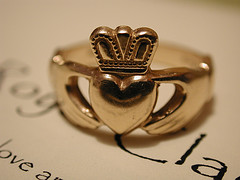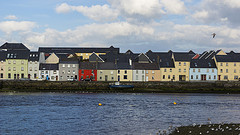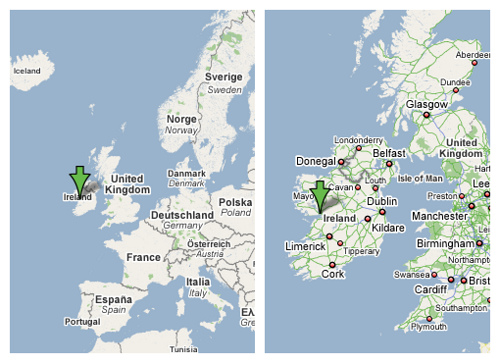3. The Claddagh Ring
Focus on
|
Now that Tom is in Ireland he is really interested in asking people for some information about THE CLADDAGH RING, a traditional Irish ring which has been given to every woman in his family. It represents love, loyalty and friendship. As you can see in the picture on the right, it is made of two clasped hands which represent friendship, the heart represents love and the crown loyalty. |
 Imagen de Royal Claddagh en Flickr. Licencia CC |
Culture counts
Tom headed for Claddagh, an Irish village close to the centre of Galway City. People have been gathering seafood and fishing from the area for millennia. It is one of the oldest former fishing villages in Ireland - its existence having been recorded since the arrival of Christianity in the 5th century.
Do it yourself
These are some of the origins, myths and history that the locals told Tom about The Claddagh Ring. Read the information and say if the statemens presented below are True or False:
THE FAMOUS CLADDAGH RING - ORIGINS, MYTHS AND HISTORY
The Claddagh Ring is believed to date back centuries. Its origins are most widely credited to the 17th century and to a young Irishman named Richard Joyce, a native of Claddagh, a tiny fishing village on the coast of Galway.
It is a romantic tale. On a ship bound for the West Indies plantations, Joyce and his fellow shipmates were captured by Algerian pirates and ferried to the African country. Joyce was sold to a Moorish goldsmith, who trained the young Irishman in the craft.
In 1689, an amnesty was declared. Won over by the young Irishman's charm and craftsmanship, his Moorish master offered Joyce half his wealth and the hand of his only daughter in marriage. But Joyce's heart belonged in Ireland.
On returning to his native Claddagh, Richard gave a ring to his sweetheart. They married and Joyce set up a goldsmith shop from where the first Claddagh Rings, bearing his inscription RI (the initial letters of Richard), were produced.
But like many other elements of Irish culture and heritage, the precise source of the Claddagh Ring is in dispute. Another story tells of a Margaret Joyce (no relation to Richard), who married a wealthy Spanish merchant by the name of Domingo de Rona. The Spanish husband died, bequeathing the Irish woman a large fortune. Joyce put the new riches to good work, doing many charitable works and building bridges in the western counties. She was supposedly rewarded for her kindness when an eagle dropped the original Claddagh Ring into her lap.
Others ascribe the origins of Claddagh Ring to ancient Celtic times. The mythical Beathauile is supposed to represent the Crown. Dagda, father of the Celtic gods, represents the right hand of the Claddagh Ring. Anu, ancestral and universal mother of the Celts, represents the left hand.
Claddagh is also believed to be one of the oldest fishing villages in Ireland. For centuries, fishermen from the area took to sea with the Claddagh crest on their ships and sails. The crest was used for indentification purposes – fishermen from outside the area fishing in their waters were chased away or killed.
Another mythical tale is told of an ancient king who became besotted with a peasant girl. Class distinctions stood between the two and the king's love went unrequited and unfulfilled. In the depths of depression, the king took his own life. His dying wish was for his hands to be chopped off and placed around his heart as a symbol of his undying love and affection for the true love.
Unsurprisingly in a Christian country, there are also religious references to the Claddagh Ring. It is linked with the Holy Trinity of God, Jesus Christ and the Holy Ghost. Similar to the way the shamrock is supposed to depict this Holy Trinity, the Crown on the ring is said to represent The Father, the left hand represents The Son, and the right hand represents the Holy Ghost.
Far from being from exclusively Gaelic or Celtic origins, the Claddagh draws on inspiration from Europe, according to others. The similarities between the Claddagh Ring and a popular group of finger rings, called Faith Rings or Fede, has been noted. Fede rings date back from Roman times and were popular in Europe in Medieval times. These rings also took the form of two clasped hands, symbolizing faith, trust or brotherhood.
Whichever tale you choose to believe, there is no doubting that the Claddagh Ring is as popular today as it ever was. Ironically, the mass exodus from Connemara during the Great Famine 1845-49 to North America contributed to its enduring legacy. Kept as heirlooms and passed on from generation to generation, the Claddagh Ring gain currency in the USA and Canada in the late 19th century.
Nearer home, the Claddagh Ring was the only ring made in Ireland ever worn by Queen Victoria. Later King Edward VII and Queen Alexandra would each wear one. In 1962, Prince Rainier and Princess Grace of Monaco were presented with gifts emblazoned with the Claddagh Ring motif set in Connemara marble.
The Claddagh Ring as both a concept and a practical way of displaying love, loyalty, affection and identity has survived – a proud Irish symbol sitting comfortably in the 21st century.
Feedback
False
Joyce was a native of Claddagh, but he was trained in the craft by a Moorish goldsmith who bought him as a slave.
Feedback
True
The Moorish master offered Joyce half his wealth and the hand of his only daughter in marriage. But Joyce's heart belonged in Ireland where he would marry his sweetheart.
Feedback
True
That's the story of Margaret Joyce who was supposedly rewarded for her kindness when an eagle dropped the original Claddagh Ring into her lap.
Feedback
False
The crest was used by fishermen of the area for indentification purposes – fishermen from outside the area fishing in their waters were chased away or killed.
Feedback
False
According to this mythical tale the hands belong to the ancient king who fell in love with this peasant girl. The king wanted his hands to be chopped off and placed around his heart as a symbol of his undying love and affection for the true love.
Feedback
False
The mass exodus from Connemara during the Great Famine 1845-49 to North America contributed to the enduring legacy of the Claddagh ring.
Feedback
True
Queen Victoria, King Edward VII and Queen Alexandra would each wear one. In 1962, Prince Rainier and Princess Grace of Monaco were presented with gifts emblazoned with the Claddagh Ring motif set in Connemara marble.
Moving on
Over the winter of 2013, Galway City Museum worked with a local animator, Edith Pieperhoff, and a group of teenagers from across Galway city and county to research, write and develop a series of short stop-motion animations relating to the historic Claddagh Village, its traditions and superstitions.
Watch the animated presentation they created about the origins of the Claddagh Ring. After watching the presentation retell the story using your own words.
Not only having a Claddagh ring is symbolic, but also the different ways of wearing it have a specific meaning. Watch the video below about how to wear this ring and answer these questions:
1. What's the meaning of the ring worn on the right hand with the heart facing outwards?
2. What's the meaning of the ring worn on the right hand with the heart facing inwards?
3. What's the meaning of the ring worn on the left hand with the heart facing inwards?
1. A ring worn on the right hand with the heart turned outwards is indicates that the person is single and looking for a relationship.
2. The ring worn on the right hand with the heart turned inwards signals that the person is in a relationship or that someone has captured their heart.
3. The ring worn on the left hand with the heart turned inwards means the wearer is married.

